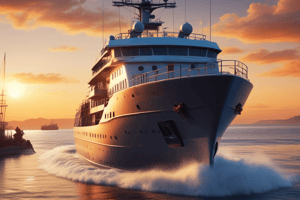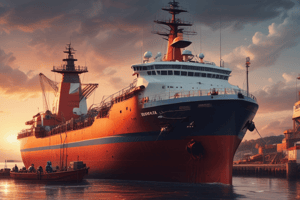Podcast
Questions and Answers
State the objectives of the International Safety Management code.
State the objectives of the International Safety Management code.
The objectives are to ensure safety at sea, prevent pollution, and continuously improve safety management skills of personnel.
State how the objectives of the International Safety Management code are achieved.
State how the objectives of the International Safety Management code are achieved.
The objectives are achieved through implementing a Safety Management System (SMS), conducting regular audits, and ensuring compliance with regulations.
State the minimum size of vessel required to comply with the International Safety Management code.
State the minimum size of vessel required to comply with the International Safety Management code.
Vessels of 500 gross tonnage and above are required to comply with the code.
With reference to planning a voyage, state the factors to be considered regarding fuel.
With reference to planning a voyage, state the factors to be considered regarding fuel.
With reference to planning a voyage, state the factors to be considered regarding lubricating oil.
With reference to planning a voyage, state the factors to be considered regarding lubricating oil.
With reference to planning a voyage, state the factors to be considered regarding fresh water.
With reference to planning a voyage, state the factors to be considered regarding fresh water.
List THREE complementary techniques used to manage garbage according to Annex V of the MARPOL convention.
List THREE complementary techniques used to manage garbage according to Annex V of the MARPOL convention.
What information should be entered in the Garbage Record Book when garbage is discharged into the sea?
What information should be entered in the Garbage Record Book when garbage is discharged into the sea?
In which area must no garbage whatsoever be disposed of overboard?
In which area must no garbage whatsoever be disposed of overboard?
State a form of garbage that is prohibited from disposal into the sea.
State a form of garbage that is prohibited from disposal into the sea.
State THREE possible consequences of water contamination of marine diesel oil during bunkering.
State THREE possible consequences of water contamination of marine diesel oil during bunkering.
List THREE sources of contamination of fuel by water on board a vessel.
List THREE sources of contamination of fuel by water on board a vessel.
Describe TWO separate tests that would indicate the presence of water in marine diesel oil.
Describe TWO separate tests that would indicate the presence of water in marine diesel oil.
How is humidity controlled if the air in an air conditioning system is too dry?
How is humidity controlled if the air in an air conditioning system is too dry?
How is humidity controlled if the air in an air conditioning system is too wet?
How is humidity controlled if the air in an air conditioning system is too wet?
How is fire protection between compartments in air trunking achieved in air conditioning systems?
How is fire protection between compartments in air trunking achieved in air conditioning systems?
How is the supply of air into a compartment controlled in air conditioning systems?
How is the supply of air into a compartment controlled in air conditioning systems?
How is overpressure of the air circuit prevented in air conditioning systems?
How is overpressure of the air circuit prevented in air conditioning systems?
Explain the principles of reverse osmosis as a method of producing fresh water.
Explain the principles of reverse osmosis as a method of producing fresh water.
Explain the types of motion in maritime context: roll, pitch, yaw, surge, and heave.
Explain the types of motion in maritime context: roll, pitch, yaw, surge, and heave.
State the objectives of the International Safety Management code.
State the objectives of the International Safety Management code.
How are the objectives of the International Safety Management code achieved?
How are the objectives of the International Safety Management code achieved?
State the minimum size of vessel required to comply with the International Safety Management code.
State the minimum size of vessel required to comply with the International Safety Management code.
With reference to planning a voyage, state the factors to be considered regarding fuel.
With reference to planning a voyage, state the factors to be considered regarding fuel.
With reference to planning a voyage, state the factors to be considered regarding lubricating oil.
With reference to planning a voyage, state the factors to be considered regarding lubricating oil.
With reference to planning a voyage, state the factors to be considered regarding fresh water.
With reference to planning a voyage, state the factors to be considered regarding fresh water.
State THREE possible consequences of water contamination of marine diesel oil during bunkering.
State THREE possible consequences of water contamination of marine diesel oil during bunkering.
Explain the types of motion in maritime context: roll, pitch, yaw, surge, and heave.
Explain the types of motion in maritime context: roll, pitch, yaw, surge, and heave.
List the THREE complementary techniques used to manage garbage according to Annex V of the MARPOL convention.
List the THREE complementary techniques used to manage garbage according to Annex V of the MARPOL convention.
Explain TWO separate tests that would indicate the presence of water in marine diesel oil during bunkering.
Explain TWO separate tests that would indicate the presence of water in marine diesel oil during bunkering.
Describe how fire protection between compartments in air trunking is achieved in air conditioning systems.
Describe how fire protection between compartments in air trunking is achieved in air conditioning systems.
Explain how the supply of air into a compartment is controlled in air conditioning systems.
Explain how the supply of air into a compartment is controlled in air conditioning systems.
Explain how overpressure of the air circuit is prevented in air conditioning systems.
Explain how overpressure of the air circuit is prevented in air conditioning systems.
Explain, with the aid of sketches, the principles of reverse osmosis as a method of producing fresh water.
Explain, with the aid of sketches, the principles of reverse osmosis as a method of producing fresh water.
Explain the types of motion in maritime context: roll, pitch, yaw, surge, and heave.
Explain the types of motion in maritime context: roll, pitch, yaw, surge, and heave.
State THREE possible consequences of water contamination of fuel by water on board a vessel.
State THREE possible consequences of water contamination of fuel by water on board a vessel.
Flashcards are hidden until you start studying
Study Notes
International Safety Management Code
- The objectives of the International Safety Management (ISM) Code are to ensure safety at sea, prevent human injury or loss of life, and avoid damage to the environment and property.
- The objectives of the ISM Code are achieved through a safety management system that includes company responsibilities, designation of personnel, and reporting.
Vessel Compliance
- The minimum size of vessel required to comply with the ISM Code is 500 gross tons.
Voyage Planning
Fuel
- Factors to consider when planning a voyage regarding fuel include distance, speed, cargo, and weather conditions.
Lubricating Oil
- Factors to consider when planning a voyage regarding lubricating oil include type of oil, quantity required, and storage capacity.
Fresh Water
- Factors to consider when planning a voyage regarding fresh water include quantity required, storage capacity, and method of producing fresh water.
Garbage Management
Annex V of MARPOL Convention
- Three complementary techniques used to manage garbage according to Annex V of the MARPOL Convention are incineration, compacting, and storage.
- Information to be entered in the Garbage Record Book when garbage is discharged into the sea includes date, time, position, and type of garbage.
Prohibited Disposal Areas
- No garbage whatsoever can be disposed of overboard in the North Sea and Baltic Sea Special Area.
Prohibited Garbage
- One form of garbage prohibited from disposal into the sea is plastic.
Fuel Contamination
Consequences
- Three possible consequences of water contamination of marine diesel oil during bunkering are corrosion of fuel tanks and systems, damage to engines, and reduction in fuel efficiency.
- Three possible consequences of water contamination of fuel by water on board a vessel are corrosion of fuel tanks and systems, damage to engines, and reduction in fuel efficiency.
Detection Tests
- Two separate tests that would indicate the presence of water in marine diesel oil during bunkering are crackle test and centrifuge test.
Air Conditioning Systems
Humidity Control
- If the air in an air conditioning system is too dry, humidity is controlled by adding moisture through a humidifier.
- If the air in an air conditioning system is too wet, humidity is controlled by removing moisture through a dehumidifier.
Fire Protection
- Fire protection between compartments in air trunking is achieved through the use of fire-resistive materials and fire dampers.
Air Supply Control
- The supply of air into a compartment is controlled through the use of dampers and fans.
Overpressure Prevention
- Overpressure of the air circuit is prevented through the use of pressure relief valves and sensors.
Fresh Water Production
- The principles of reverse osmosis as a method of producing fresh water involve the use of a semi-permeable membrane to remove salt and impurities from seawater, resulting in fresh water.
Maritime Motions
- The types of motion in maritime context are:
- Roll: rotation around the longitudinal axis
- Pitch: rotation around the transverse axis
- Yaw: rotation around the vertical axis
- Surge: movement in a forward or aft direction
- Heave: movement in an upward or downward direction
Studying That Suits You
Use AI to generate personalized quizzes and flashcards to suit your learning preferences.




